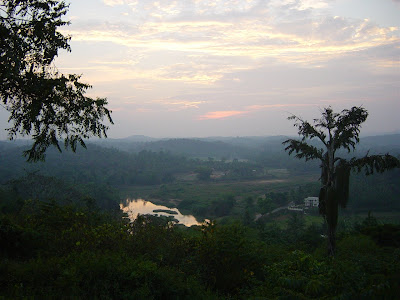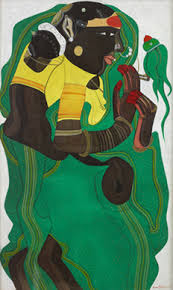My wife and I found that there were a lot of places thin our immediate reach worth spending a day. We used the public transport for conveyance and were happy eating out in village teashops or roadside joints. Most of the times we didn’t have a specific landmark to visit. We strolled through the country roads, talked to the children, made friendship with the strangers and moved on. My son in particular was very receptive to new experiences.
We went to a place called Oorkadavu at the outskirts of Kozhikode city, amazingly serene and picturesque, to spend an occasional evening. The river Chaliyar was quietly flowing and we walked through its banks to a bend. The sun was setting over the plantations and it was a perfect moment to reflect on our lives. Life had been a difficult teacher, always demanding and never giving us any good grades, but we were not going to complain. Not that we believed in the unquestionable authority of the teacher, but we had a feeling that we became sort of a refined lot after taking many setbacks in a row. There was absolutely no bitterness.
Slowly our itinerary took a bigger route. We toured the neighbouring district, Wayanad. We greeted the new millennium in a modest hotel room at a place called Sultan Battery, 2000 odd feet above MSL. Bhajans from the road down below wafted through the early morning mist and woke us up. A small group of people, men and women wearing white cloths could be seen as abstract figures in motion. They used simple musical instruments for accompaniment
We didn’t join the conducted tours arranged by travel agents and never hired any guides. At times auto rickshaw drivers doubled as our guides even without a formal request. Prakasan was one such. He drove us to the Soochippara falls in his newly acquired vehicle.
The roads were ill-maintained and he took great pains to move us to the nearest motorable point near the waterfalls. Then on, it was a dangerous trek upwards through the forest. If one slipped from the narrow trekking path, one was bound to fall into a steep gorge with practically no chance for immediate help. The area was uninhabited. We thought of giving up and return through the same vehicle. Luckily Prakasan was made of different stuff and he came forward to become our impromptu guide. Trusting him fully we climbed our way up and the light was receding. We wanted to get back to our base before sunset. It never crossed our mind that the fellow, known to us for hardly two hours could snatch away my wife’s gold chain or signal his collaborators to pound on us while trekking. We were not worried. After the tedious trail, all of us settled down on a rock near to the bottom of the two hundred feet waterfall, took to its comforting and forgot all our troubles.
We visited the heritage sites too. Many of them were raced to ground and even the remnants were not visible. A group of children from the neighbouring UP School at the Pazhassi Raja fort volunteered to show us around. Somebody had written obscene graffiti on the wall and the students seemed to be worried about our seeing it.
Pazhassi Raja fought his last battle here.

One of the boys pinpointed to a place. I was reminded of a similar statement made by a villager sometime back when we visited Lokanar Kavu to get a feel of the great martial arts master, Thacholi Othenan.
See, Othenan was felled here by treachery, he said.
We didn’t know how to respond. There were no signs of any monument in sight, only a Palmyra palm leaf was dug into the ground. It stood as a befitting memorial. All others, people and monuments were racing towards oblivion.
We went to Thirunelli and stayed with the Warrier family who were in charge of the daily chores at the temple. A room or two were earmarked for guests like us willing to pay for the hospitality. The Warriers kept us occupied with interesting information about the place. The history of the temple was engaging dating back to an eighteenth century ego-clash between kings which ultimately resulted in the construction of the temple in the thick of the forest. We listened to the couple sitting on a wooden bench in the verandah while a simple vegetarian dinner was being readied inside.
Thirunelli also provided us the venue for first meeting with the adivasis. We were apprehensive about communicating with them as we thought the language would be completely alien. Another preconceived notion was about their dress. We met a small group of Adivasi youths at the village square and found them clad in normal clothes- shirt and lungies. Their Malayalam was not grotesque, either. We requested them to escort us into the forest and they happily agreed. The boys were in their late teens, drifting after discontinuing their education. None of them seemed to harbour any fond memories about schooldays. They guided us through a lone path running by the side of a stream at a slow pace. Our silly questions on life in the jungle were answered in detail. The main topic centered on rouge-elephants and we were given essential lessons in identifying them, especially the moments of vulnerability. We stepped into the stream when we felt tired and ate boiled eggs and bananas. Further journey by crossing the stream into thick woods was vetoed by me as all the three of us, my wife and son especially were increasingly getting shaky, gripped by an unknown fear.
Let’s return
We pleaded to the sons of the forest.
On our way back we found a house aptly named as Koomankolly, complete with compound wall and iron gate. The old tile-roofed house was owned by the famous Malayalam novelist P.Valsala to write her books in peace.
Hey, the wild elephants move around this place, I exclaimed.
The adivasi friends agreed in unison.
It was revealed to me instantly that we had to travel quite a long way to reach the forest. Until we felt that the pulsating quietness of the woods was a part ourselves.
(to be continued)
